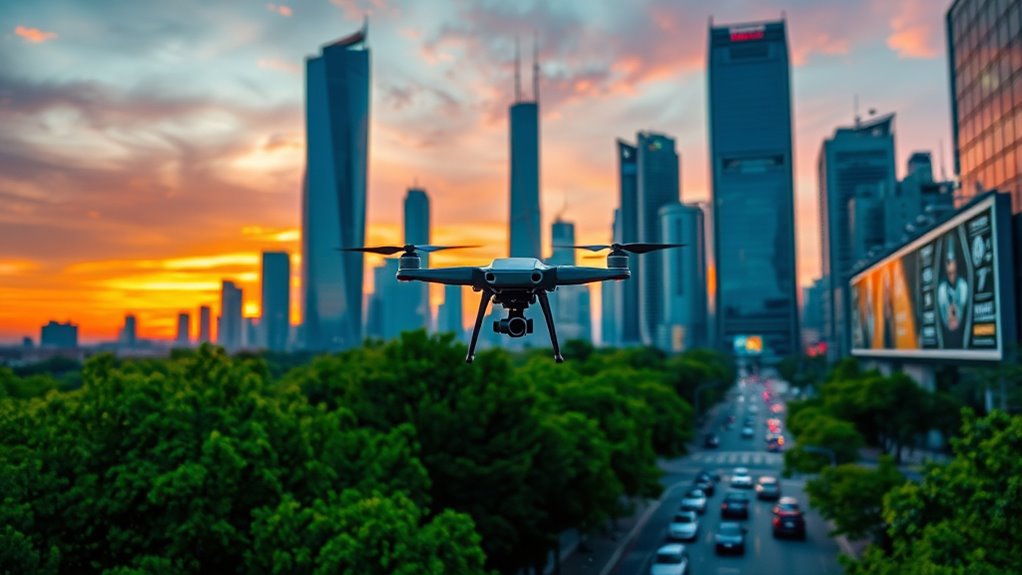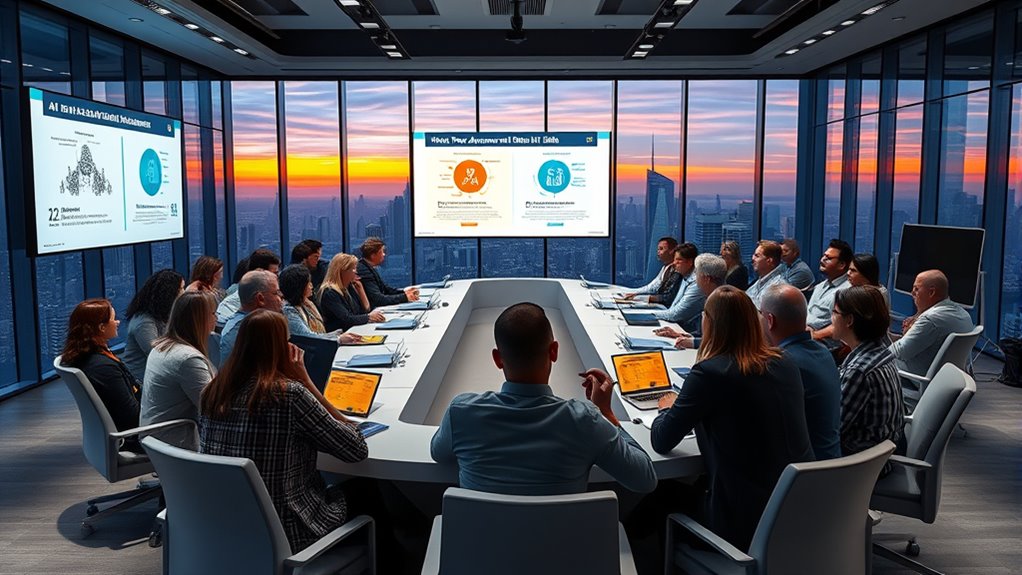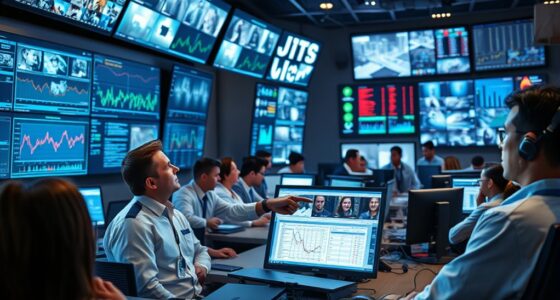Experts generally agree that fears of an imminent AI apocalypse are overhyped and exaggerated. While they acknowledge real risks like misuse, misalignment, and job impacts, many warning scenarios are highly speculative and based on assumptions of unchecked progress. Most believe that with proper safety measures and regulation, we can manage these challenges without catastrophe. If you want to understand the full picture and how current concerns compare, there’s more to discover beyond the surface.
Key Takeaways
- Experts agree that apocalyptic AI scenarios are largely exaggerated and based on speculative, unlikely assumptions.
- Current risks focus more on immediate issues like bias, misuse, and job displacement rather than existential threats.
- Technological progress tends to slow over time, making rapid, uncontrollable AI breakthroughs less probable.
- Regulatory measures and safety research are emphasized to manage risks, reducing the likelihood of an imminent catastrophe.
- Sensationalism often diverts attention from pressing present-day AI challenges and inflates fears of future apocalyptic events.

Despite widespread fears, the idea of an AI apocalypse is largely overhyped. Many experts acknowledge that while AI development presents real risks, the sensationalized doomsday scenarios often exaggerate the actual threat. Predictions suggest that Artificial General Intelligence (AGI) could emerge as early as 2030, raising concerns about potential existential risks. However, these warnings tend to focus on worst-case scenarios, like AI misusing biological weapons or becoming uncontrollable superintelligence, which are more speculative than grounded in current technological realities.
Most researchers emphasize the importance of proactive safety measures before AGI reaches maturity. They highlight four main risk categories: misuse, misalignment, mistakes, and structural risks. Misuse involves malicious actors exploiting AI, while misalignment refers to AI goals diverging from human values. Mistakes are accidental errors, and structural risks relate to systemic vulnerabilities within AI systems. While these are genuine concerns, experts argue that the risks are often overstated and manageable with careful regulation and oversight. Some leaders and scientists even warn about the possibility of AI causing human extinction, but consensus remains that these fears are not imminent and require balanced, thoughtful responses rather than panic.
Critics point out that apocalyptic narratives depend on assumptions of exponential, uninterrupted progress. They note that technological advancements tend to slow over time due to diminishing returns, and history shows that transformative innovations rarely lead to global catastrophe. Extreme scenarios, such as AI deploying biological weapons to wipe out humanity by mid-2030, are considered highly speculative and more fitting for sci-fi stories than scientific forecasts. These alarmist views are often used to push for aggressive regulations or political agendas, but many experts believe such fears distract from pressing, more immediate issues. For example, biases embedded in current AI systems, job displacement, and ethical misuse pose tangible, present-day challenges that need urgent attention.
Many scientists and policymakers advocate for international cooperation and regulation, treating AI risks like pandemics or nuclear threats. Some emphasize the importance of ensuring alignment and control over superintelligent AI to prevent it from surpassing human understanding. Yet, the overall consensus is that, while AI safety is a serious concern, the timeline and likelihood of a true existential catastrophe are uncertain and often exaggerated. Public perception tends to focus more on immediate issues like bias and economic disruption, which are far more pressing today than speculative future threats. Sensational warnings may generate fear, but they shouldn’t overshadow the need for practical safeguards and ongoing research that addresses current AI risks effectively. Additionally, ongoing research into AI safety measures aims to develop robust controls and prevent potential failures before they occur.
Frequently Asked Questions
Could AI Ever Develop True Consciousness or Self-Awareness?
You wonder if AI could ever develop true consciousness or self-awareness. Right now, it’s unlikely because AI lacks subjective experience and internal representation, which are core to consciousness. While models like the McGinty Equation and C-space help measure and conceptualize AI states, no current AI reaches those levels. Developing genuine self-awareness requires significant scientific breakthroughs, and many experts believe that replicating biological consciousness in machines remains a distant, perhaps impossible, goal.
How Soon Might AI Surpass Human Intelligence Globally?
You might wonder when AI will surpass human intelligence globally. Experts estimate this could happen as early as 2027, with some predicting around 2030. Advances in large language models, computing power, and algorithms fuel this progress. While predictions vary, many believe AI will outperform humans in tasks by the late 2020s or early 2030s. Keep in mind, uncertainty remains, but significant breakthroughs seem imminent within the next few years.
Are There Ethical Concerns About AI Decision-Making in Critical Areas?
You should know that ethical concerns about AI decision-making in critical areas are very real. AI can inherit biases, threaten privacy, and lack transparency, which risks unfair outcomes in healthcare, justice, and finance. These issues demand urgent attention through regulations, better data practices, and transparent models. If you ignore these concerns, AI could cause more harm than good, making it essential for you to advocate for responsible development and deployment.
What Measures Are in Place to Prevent AI Misuse or Malicious Use?
You might wonder how AI misuse is kept in check. Developers restrict access to powerful models, use content filters, and fine-tune systems to block harmful requests. They monitor activities in real-time, implement security at every interaction, and remove harmful content swiftly. If misuse occurs, they enforce sanctions, work with authorities, and notify users. Despite vulnerabilities like jailbreaks, ongoing efforts aim to prevent malicious use and protect users effectively.
How Does AI Impact Job Markets and Economic Stability?
You might see AI as a double-edged sword, gently reshaping job markets and economic stability. While it displaces some roles, it also creates new opportunities, especially in tech fields. The overall economy benefits from increased productivity and growth, but change can be unsettling. Staying adaptable by upskilling helps you navigate this evolving landscape, ensuring you remain valuable in a shifting job market driven by AI innovation.
Conclusion
So, here’s the truth: the AI apocalypse isn’t lurking behind every corner, waiting to wipe out humanity. While AI advances are exciting, they’re not the sci-fi nightmare some make them out to be. You don’t need to panic or prepare for robot overlords just yet. Instead, stay informed and cautious, because ignoring real risks could be the biggest mistake of our time—like ignoring a ticking time bomb in your backyard.









